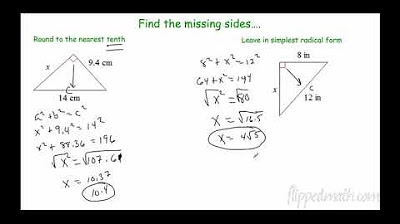Order of Operations: A Step-By-Step Guide | PEMDAS | Math with Mr. J
Summary
TLDRIn 'Math with Mr. J.', the video focuses on the critical concept of the order of operations, essential for solving mathematical problems consistently. Mr. J. introduces the acronym PEMDAS to remember the sequence: Parentheses, Exponents, Multiplication and Division (from left to right), and Addition and Subtraction (also from left to right). He illustrates this with step-by-step examples, ensuring viewers understand how to apply these rules to reach the correct solution.
Takeaways
- 📝 The order of operations is a set of rules that ensures everyone solves math problems in the same way, leading to consistent solutions.
- 🔢 The acronym PEMDAS helps remember the order: Parentheses, Exponents, Multiplication and Division (from left to right), and Addition and Subtraction (from left to right).
- 🌟 Parentheses have the highest priority and should be solved first in any expression.
- 🚀 Exponents are the next priority after parentheses and indicate a number should be squared or raised to another power.
- ➗✖️ Multiplication and division are on the same level of priority, and if both are present, they are performed from left to right.
- 🔄 Addition and subtraction have the same priority and should be done from left to right when both are present in an expression.
- 📉 In the example 30 divided by (13 - 8), the problem inside the parentheses is solved first, resulting in 5, then the division is performed, yielding 6.
- 📈 In the problem 16 - 5 * 3 + 12, multiplication is performed first (5 * 3 = 15), followed by subtraction and addition from left to right, resulting in 13.
- 💫 The expression 7 squared minus 14 times 2 first calculates the exponent (7^2 = 49), then the multiplication (14 * 2 = 28), and finally the subtraction, giving 21.
- 🔄 For the problem 18 divided by (6 + 3) times 15, the operation inside the parentheses is solved first (6 + 3 = 9), followed by division (18 / 9 = 2), and finally multiplication (2 * 15 = 30).
- 👍 The video emphasizes the importance of following the order of operations step-by-step to arrive at the correct answer.
Q & A
What is the purpose of the order of operations in mathematics?
-The order of operations ensures that everyone solves mathematical problems using the same set of rules, leading to consistent and correct solutions.
What does the acronym PEMDAS stand for in the context of the order of operations?
-PEMDAS stands for Parentheses, Exponents, Multiplication and Division (from left to right), and Addition and Subtraction (from left to right).
Why is it important to start with parentheses when solving an expression?
-Parentheses indicate the highest priority in the order of operations, so they must be solved first to determine the values that will be used in the rest of the expression.
How are multiplication and division treated in the order of operations?
-Multiplication and division are on the same level of priority. If both are present in an expression, they are performed from left to right.
What is the correct order to perform addition and subtraction in an expression?
-Addition and subtraction are also on the same level of priority, and they should be performed from left to right.
In the example 30 divided by (13 minus 8), what is the first step according to the order of operations?
-The first step is to solve the expression within the parentheses, which is 13 minus 8.
What is the result of the calculation 16 minus 5 times 3 plus 12?
-First, perform the multiplication (5 times 3), then the subtraction (16 minus the result), and finally the addition (plus 12), resulting in 13.
In the expression 7 squared minus 14 times 2, which operation should be performed first?
-The exponent operation (7 squared) should be performed first, as it has the next highest priority after parentheses.
How is the expression 18 divided by (6 plus 3) times 15 simplified step by step?
-First, solve the parentheses (6 plus 3), then perform the division (18 divided by the result), and finally the multiplication (times 15), resulting in 30.
What is the final answer to the example where the expression is 16 minus 5 times 3 plus 12?
-Following the order of operations, the final answer is 13.
Can you provide an example of how the order of operations is applied in a real-world scenario?
-In a real-world scenario, such as calculating the total cost of items with a discount and tax, the order of operations ensures that the discount is applied first, followed by the tax calculation, resulting in the correct final amount owed.
Outlines

Esta sección está disponible solo para usuarios con suscripción. Por favor, mejora tu plan para acceder a esta parte.
Mejorar ahoraMindmap

Esta sección está disponible solo para usuarios con suscripción. Por favor, mejora tu plan para acceder a esta parte.
Mejorar ahoraKeywords

Esta sección está disponible solo para usuarios con suscripción. Por favor, mejora tu plan para acceder a esta parte.
Mejorar ahoraHighlights

Esta sección está disponible solo para usuarios con suscripción. Por favor, mejora tu plan para acceder a esta parte.
Mejorar ahoraTranscripts

Esta sección está disponible solo para usuarios con suscripción. Por favor, mejora tu plan para acceder a esta parte.
Mejorar ahoraVer Más Videos Relacionados

The First Day of High School: Establishing Classroom Expectations and Building Relationships

Jejak Matematika di Berbagai Budaya: Etnomatematika dalam Kehidupan Sehari-hari

Solving Two-Step Equations | Algebra Equations

(BOCORAN) SOAL TES MASUK SMP/MTs‼️PART 1

Lisa, wake up! - Conversation in English - English Communication Lesson

Geometry – 7.1 Pythagorean Theorem and Its Converse
5.0 / 5 (0 votes)
